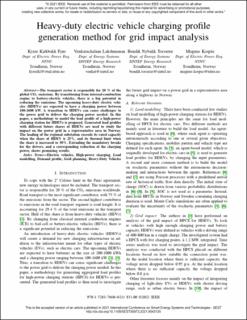Heavy-duty electric vehicle charging profile generation method for grid impact analysis
Chapter
Accepted version

Åpne
Permanent lenke
https://hdl.handle.net/11250/2822947Utgivelsesdato
2021Metadata
Vis full innførselSamlinger
- Institutt for elkraftteknikk [2443]
- Publikasjoner fra CRIStin - NTNU [37703]
Originalversjon
10.1109/SEST50973.2021.9543135Sammendrag
The transport sector is responsible for 20 % of the global CO 2 emissions. By transitioning from internal-combustion engine to battery-electric vehicles, there is a big potential in reducing the emissions. The upcoming heavy-duty electric vehicles (HDEVs) are expected to have a charging power between 100-1600 kW. A transition to HDEVs can cause challenges to the power grid to deliver the charging power needed. In this paper, a methodology to model the load profile of a high-power charging station for HDEVs is proposed. Generated load profiles with different future shares of HDEVs are used to study the impact on the power grid in a representative area in Norway. The loading of the regional substation exceeds its rated capacity when the share of HDEV is 25%, and its thermal limit when the share is increased to 50%. Extending the mandatory breaks for the drivers, and a corresponding reduction of the charging power, shows promising results.